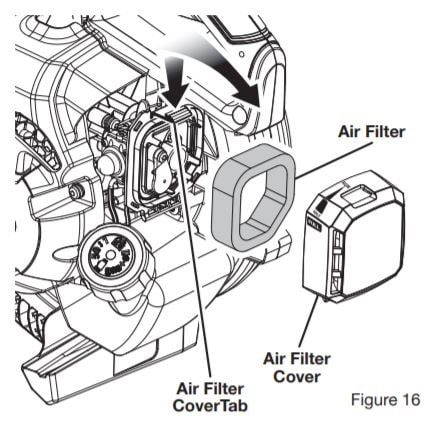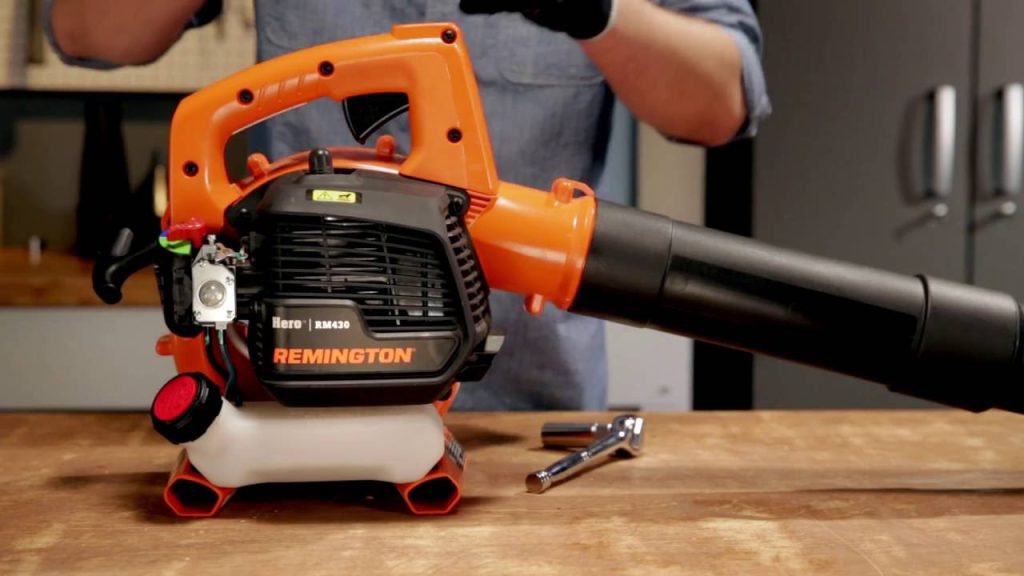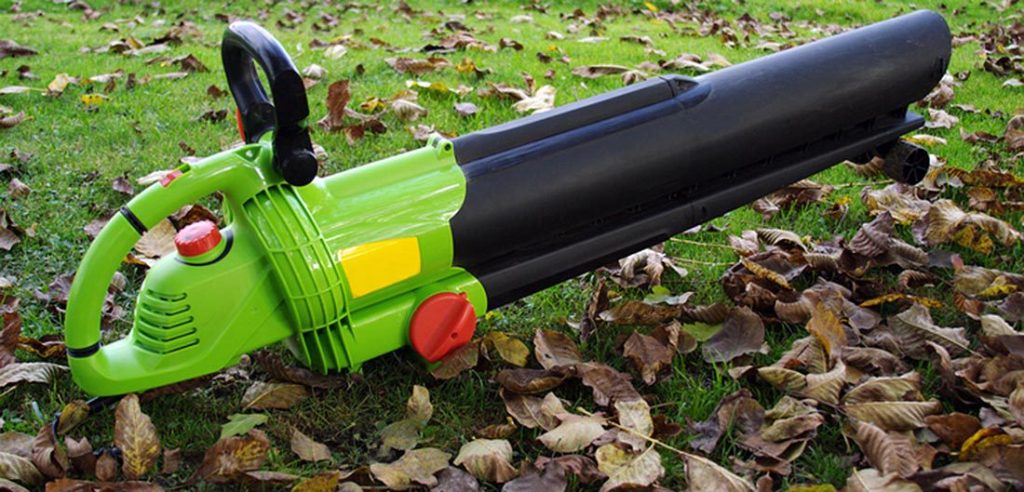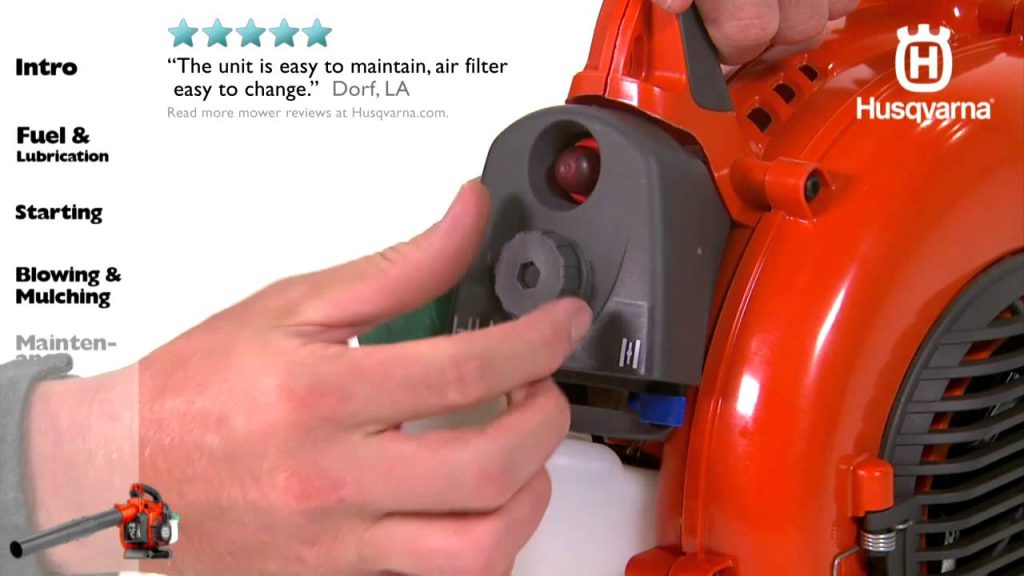Maintaining and cleaning your leaf blower is essential for optimal performance and longevity.
In this article, we will provide some simple and practical tips on keeping your leaf blower in top shape.
From regular maintenance routines to proper cleaning techniques, we’ve got you covered.
So, let’s get started and ensure that your leaf blower is always ready to tackle the autumn leaves.
Regular Maintenance
Inspect Air Filter
Regularly inspecting and cleaning or replacing the air filter of your leaf blower is crucial to ensure it functions at its best. An air filter clogged with dust, debris, or dirt can restrict airflow and lead to poor performance.
To inspect the air filter, carefully remove it from the blower housing and inspect for any signs of damage or excessive dirt buildup. If the filter is dirty, gently clean it with a soft brush or wash it with soap and water if it is washable. If the filter is damaged or worn, replace it with a new one to maintain optimal airflow.
Clean or Replace Spark Plug
The spark plug is crucial in the leaf blower’s ignition process. Over time, the spark plug can become dirty or corroded, leading to difficulties starting the blower or poor performance.
Check the spark plug regularly and clean off any dirt or debris that may have accumulated around it. If the spark plug is heavily corrupted or damaged, replacing it with a new one is best to ensure efficient ignition and smooth operation.
Check Fuel System
The fuel system is integral to your leaf blower and should be regularly checked to ensure proper functioning. Start by inspecting the fuel tank for any signs of leaks or damage.
Examine the fuel lines and connections for cracks, leaks, or blockages. If you notice any issues, it is essential to address them promptly. Consult your leaf blower’s user manual for instructions on fixing minor fuel system problems, or seek professional servicing.
Inspect Cooling System
The cooling system of your leaf blower helps prevent overheating during prolonged use. Inspect the cooling fins and vents for any blockages caused by debris or dirt.
If you notice any obstructions, clear them away using a soft brush or compressed air. This will ensure proper airflow and prevent the blower from overheating, maximizing its lifespan and performance.
Inspect and Tighten Fasteners
Leaf blowers vibrate during operation, which can cause fasteners to become loose over time. Regularly inspect all the fasteners on your blower, including screws, bolts, and nuts, and tighten them if necessary.
Loose fasteners can lead to excessive vibration, rattling, or even parts becoming detached from the blower. You can maintain the blower’s stability and prevent potential hazards by taking a few minutes to check and tighten the fasteners.
Inspect and Lubricate Moving Parts
To ensure smooth operation and prevent excessive wear and tear, it is essential to inspect and lubricate the moving parts of your leaf blower.
Check the owner’s manual for specific lubrication points and follow the manufacturer’s recommendations. As instructed, apply lubricating oil or grease to bearings, gears, and other moving parts. Regular lubrication minimizes friction, extends the blower’s life, and ensures efficient performance.
Cleaning the Leaf Blower
Prepare the Leaf Blower for Cleaning
Before cleaning the leaf blower, it is essential to take some precautions to ensure your safety. First, make sure the blower is turned off and disconnected from any power source.
If your leaf blower is battery-powered, remove the Battery to eliminate the risk of accidental startups. Additionally, always wear protective gear, including safety glasses, gloves, and a dust mask, to shield yourself from debris or chemicals during cleaning.
Cleaning the Blower Housing
The blower housing is prone to accumulating dirt, debris, and leaves. Regular housing cleaning is necessary to maintain optimal airflow and prevent clogs. Use a soft brush or cloth to gently remove the debris from the housing.
You can also use compressed air or a leaf blower set to a low setting to blow away any loose particles. Avoid using water or harsh cleaning chemicals, which can damage the blower’s components.
Cleaning the Air Vents and Cooling System
Your leaf blower’s air vents and cooling system play a vital role in preventing overheating. Start by inspecting the vents for any blockages caused by leaves, dust, or debris. Carefully remove any obstructions using a soft brush or compressed air.
Ensure that the cooling fins are free from dirt or debris, which can impede proper airflow. Gently clean them using a brush or compressed air to maintain optimal cooling efficiency.
Cleaning the Fuel System
Over time, the fuel system can accumulate dirt, clogs, or residues that can affect the leaf blower’s performance. To clean the fuel system, start by emptying the fuel tank and disposing of the fuel by local regulations.
Once the tank is empty, use a fuel system cleaner recommended by the manufacturer to remove any deposits or clogs. Follow the instructions on the cleaner and allow it to circulate through the fuel system. After the recommended time, refill the tank with fresh fuel and run the blower for a few minutes to flush out any remaining cleaner.
Cleaning the Impeller and Fan Blades
Your leaf blower’s impeller and fan blades generate the airflow necessary for blowing leaves and debris. Over time, they can become coated with dirt, grease, or debris, affecting their performance.
First, ensure the blower is turned off and disconnected from any power source to clean the impeller and fan blades. Use a soft brush or cloth to remove the dirt and debris from the blades gently. Take care not to bend or damage the blades during cleaning.
Cleaning the Spark Arrestor Screen
The spark arrestor screen is an important safety feature that prevents sparks from exiting the muffler and potentially causing fires. It can become clogged with carbon deposits over time, reducing airflow and increasing the risk of overheating.
Remove the spark arrestor screen from the muffler and use a wire brush or a cleaning solution recommended by the manufacturer. Scrub away any carbon deposits and rinse the screen thoroughly before reattaching it to the muffler.
Storing the Leaf Blower
Empty the Fuel Tank
Before storing your leaf blower for an extended period, it is essential to empty the fuel tank. Storing fuel for extended periods can cause it to deteriorate, leading to poor performance and potential damage to the blower.
Run the leaf blower until it runs out of fuel, or use a siphoning tool to remove the fuel from the tank. Dispose of the fuel properly, following local regulations, to prevent environmental contamination.
Remove the Battery (if applicable)
If your leaf blower is battery-powered, it is essential to remove the Battery before storing it. This prevents the Battery from draining over time and potentially causing damage.
Check the manufacturer’s instructions on adequately removing the Battery from your specific model. Once removed, store the Battery separately in a cool, dry place away from direct sunlight.
Clean and Dry the Leaf Blower
Before storing your leaf blower, ensure that it is clean and dry. Remove any dirt, debris, or leaves that may have accumulated during use or cleaning.
Use a cloth or soft brush to gently wipe the exterior surfaces, including the blower housing, handles, and controls. Allow the blower to air dry thoroughly before storage to prevent moisture-related issues such as rust or mold growth. Avoid using water or cleaning chemicals, which can damage the blower’s components.
Store in a Dry and Safe Location
When storing your leaf blower, choose a dry and safe location away from extreme temperatures, sunlight, and moisture. Ideal storage places include a garage, shed, or utility room.
Ensure the storage space is free from excessive dust or debris that may affect the blower’s performance. Store the leaf blower in its original box or a protective case to shield it from accidental damage if possible.
Safety Precautions
Turn Off and Disconnect
Before performing any maintenance or cleaning tasks on your leaf blower, always ensure it is turned off and disconnected from any power sources.
If you have a battery-powered blower, remove the Battery to eliminate the risk of accidental startups. Establishing this habit ensures your safety and prevents any potential accidents or injuries.
Wear Protective Gear
When operating, maintaining, or cleaning your leaf blower, wearing the appropriate protective gear is important. Safety glasses or goggles protect your eyes from debris, dust, or chemicals. Gloves provide hand protection and prevent blisters or cuts. ,
Additionally, a dust mask helps filter out fine particles that may be present during cleaning or maintenance. Wearing the correct protective gear reduces the risk of injury and ensures a safer working environment.
Avoid Loose Clothing and Jewelry
To avoid potential accidents, it is essential to avoid wearing loose clothing or jewelry while using or maintaining your leaf blower. Loose clothing can get caught in the blower’s moving parts, leading to entanglement or injury.
Remove any jewelry, such as rings, bracelets, or necklaces, that may pose a risk of entanglement. Wear fitted clothing that does not dangle or hang loosely to prevent such incidents.
Keep Hands and Feet Clear
When operating and maintaining your leaf blower, always keep your hands and feet clear of the blower’s moving parts. Avoid placing your hands or feet near the impeller, fan blades, or other rotating components.
These parts can cause severe injuries if they come into contact with your body. It is essential to exercise caution and never attempt to clear debris or obstructions while the blower is running.
Use in Well-Ventilated Areas
Leaf blowers emit exhaust fumes during operation, which can be harmful if inhaled in enclosed or poorly ventilated spaces. Always use the blower in well-ventilated areas, such as outdoors or in open garages or sheds.
Operating the blower in well-ventilated areas ensures proper air circulation and minimizes the risk of inhaling harmful exhaust fumes.
Keep Children and Pets Away
When using or maintaining your leaf blower, ensure that children and pets are kept at a safe distance. The powerful airflow and moving components of the blower can pose a danger if they come into contact with little hands or curious paws.
Create a safe zone around your work area and instruct children and pet owners to keep their distance to prevent accidents or injuries.
Inspection and Maintenance Schedule
Daily Inspection
Perform a daily inspection of your leaf blower before each use. Check the fuel level, inspect the blower housing for visible damage, and ensure all fasteners are tight and secure. Verify that the air filter is clean and in good condition.
By incorporating a daily inspection into your routine, you can promptly catch any potential issues and address them.
Weekly Inspection
Every week, perform a more thorough inspection of your leaf blower. Check the spark plug for signs of corrosion or damage and clean or replace as necessary. Inspect the fuel system for leaks, blockages, or deteriorating fuel lines.
Examine the cooling system, including the fins and vents, for any obstructions or buildup. Tighten any loose fasteners and lubricate moving parts as recommended by the manufacturer.
Monthly Inspection
Once a month, dedicate some time to a comprehensive inspection of your leaf blower. Pay attention to any changes in performance or unusual sounds. Inspect the blower tube and nozzle for any airflow damage or obstructions.
Clean the spark arrestor screen and ensure it is not clogged. It is also a good idea to perform a brief maintenance procedure on the fuel system, such as using a fuel system cleaner, to maintain optimal performance.
Annual Maintenance
Plan for an annual maintenance session for your leaf blower, preferably during the offseason or when it is not used. This is an opportunity to perform a more in-depth inspection and address any issues that may have developed over time.
Clean and lubricate all necessary parts, including the air filter, spark plug, fuel system, impeller, and fan blades. If you are uncomfortable performing the tasks, consider taking your leaf blower to a qualified technician for professional servicing.
Troubleshooting
No Power or Start
If your leaf blower fails to start or lacks power, check the power source first. If it is a battery-powered blower, ensure that the Battery is charged. Confirm that the power cord of an electric blower is connected correctly, and check for any tripped circuit breakers.
If the power source is not the issue, inspect the spark plug for signs of corrosion or damage and clean or replace it if necessary. If the problem persists, consult the manufacturer’s troubleshooting guide or seek professional servicing.
Loss of Blowing Performance
Check the air filter if you notice a decrease in your leaf blower’s blowing performance. A clogged or dirty filter can restrict airflow and reduce performance. Clean or replace the air filter as recommended by the manufacturer.
Additionally, check for any blockages in the blower tube or nozzle that may hinder the airflow. If the issue persists, consult the troubleshooting section of the user manual or seek professional assistance.
Excessive Vibration
Loose fasteners or worn components can cause excessive vibration during operation. Inspect all fasteners, including screws, bolts, and nuts, and tighten them if necessary. If the vibration persists, consult the manufacturer’s guide for recommended solutions. It is essential to address excessive vibration promptly, as it can lead to further damage or component failure.
Abnormal Sound
Unusual or abnormal sounds coming from your leaf blower can indicate underlying issues. It may be caused by loose or damaged parts, worn bearings, or a malfunctioning engine.
Inspect the blower thoroughly, checking for loose components, damaged blades, or signs of wear. If you are unsure of the cause, consult the troubleshooting section of the user manual or seek professional servicing.
Overheating
If your leaf blower is overheating, it is crucial to identify and rectify the problem to prevent further damage promptly. Ensure that the cooling system, including the fins and vents, is free from obstructions and clean.
Check the fuel mixture ratio if applicable, as a lean fuel mixture can cause the engine to overheat. If the blower continues overheating, consult the manufacturer’s troubleshooting guide or contact a qualified technician.
Fuel Leaks
Fuel leaks are a serious concern and should be addressed immediately. If you notice a fuel leak, turn off the blower and disconnect it from any power sources. Inspect the fuel tank, lines, and connections for cracks, damage, or loose fittings.
It is crucial to resolve any fuel leaks promptly to prevent fire hazards or damage to the blower. If you are uncertain about handling fuel-related issues, seek professional assistance.
Manufacturer’s Recommendations
Refer to the User Manual
Each leaf blower model may have specific maintenance and cleaning instructions provided by the manufacturer. It is essential to refer to the user manual for detailed guidance on adequately maintaining and cleaning your leaf blower. The manual will provide specific information regarding inspections, maintenance procedures, and troubleshooting steps tailored to your blower model.
Follow Specific Maintenance Instructions
Manufacturers often provide specific maintenance instructions for their leaf blowers, including recommended lubricants, cleaning products, or intervals for specific tasks.
Adhere to these instructions to ensure your blower performs optimally and avoid voiding any warranties. Following the manufacturer’s recommendations helps prolong the life of your leaf blower and ensures that it operates safely and efficiently.
Use Recommended Cleaning Products
To clean your leaf blower effectively, it is advisable to use cleaning products recommended by the manufacturer. Some cleaning chemicals or solvents can damage the blower’s components, so it is best to stick to approved products.
If specific cleaning products are not mentioned in the user manual, consult with the manufacturer or a qualified professional to ensure the safe and appropriate use of cleaning solutions.
Adhere to Warranty Terms and Conditions
If your leaf blower is under warranty, it is essential to adhere to the terms and conditions outlined by the manufacturer. Warranty coverage may include specific maintenance requirements or restrictions on self-maintenance.
Failure to comply with the warranty terms can result in the nullification of the warranty. Familiarize yourself with the warranty guidelines and seek professional assistance to protect your investment.
Professional Servicing
When to Seek Professional Servicing
While most leaf blower owners can perform regular maintenance, there are instances where professional servicing is necessary. If you encounter major mechanical issues or severe damage, or if the blower fails to perform after troubleshooting, it is recommended to seek professional servicing.
Certified technicians have the expertise, tools, and knowledge to diagnose and repair complex issues that may be beyond the scope of regular maintenance.
Choosing a Qualified Technician
When choosing a professional technician for leaf blower servicing, look for certified and experienced individuals or authorized service centers.
Ask for referrals from trusted sources or consult the manufacturer’s website for authorized service providers. Before entrusting your leaf blower to a technician, inquire about their qualifications, experience, and the warranty coverage they offer.
Costs of Professional Servicing
The cost of professional servicing for leaf blowers can vary based on factors such as the blower type, the problem’s nature, and local service rates. Essential maintenance services like tuning adjustments or check-ups may cost less than complex repairs or component replacements.
Requesting a quote or estimate from the technician before proceeding with any servicing is advisable to ensure transparency and proper budgeting.
Troubleshooting Tips
Check Power Source
If your leaf blower fails to start or lacks power, verify that you have a reliable power source. For battery-powered blowers, ensure that the Battery is fully charged. Check the power cord for electric blowers and ensure it is properly plugged in. For cordless electric blowers, check the battery level and recharge if necessary.
Inspect Spark Plug
A worn or fouled spark plug can lead to difficulty starting your leaf blower. Remove the spark plug and inspect it for any signs of corrosion, damage, or fouling. Clean the spark plug with a wire brush or replace it if necessary. Ensure that the spark plug is tightened correctly before starting the blower.
Clean Air Filter
A clogged or dirty air filter can restrict airflow and affect the performance of your leaf blower. Remove the air filter and clean it according to the manufacturer’s instructions. If the filter is excessively dirty or damaged, replace it with a new one. Ensure the air filter is properly seated and secured after cleaning or replacement.
Check Fuel System
Problems with the fuel system can cause starting issues or poor performance in leaf blowers. Inspect the fuel tank for any leaks, damage, or contamination. Check the fuel lines and connections for cracks, blockages, or loose fittings. If fuel-related problems are detected, refer to the manufacturer’s instructions for troubleshooting steps or seek professional assistance.
Inspect the Blower Tube and Nozzle
Blockages or obstructions in the blower tube or nozzle can significantly impact the blowing performance of your leaf blower. Inspect and clear the tube and nozzle of any debris, dirt, or leaves that may have accumulated. Ensure that the airflow is unobstructed and smooth throughout the entire blower pathway.
Inspect Impeller and Fan Blades
If your leaf blower is experiencing reduced performance or unusual vibrations, inspect the impeller and fan blades for any damage, debris, or imbalance. Gently clean the blades and ensure they are free from obstructions. If there are signs of damage or heavy wear, consult the manufacturer’s guide for replacement parts or seek professional assistance.
Check Ignition System
If your leaf blower fails to start or experiences intermittent power loss, it is crucial to inspect the ignition system. Check the ignition coil, spark plug wire, and kill switch for any damage or loose connections. Ensure that the kill switch is not engaged and that all electrical connections are secure. Consult the manufacturer’s troubleshooting guide or seek professional assistance for further diagnosis if necessary.
User Tips and Best Practices
Follow Correct Operating Procedures
To get the best performance and longevity from your leaf blower, it is essential to follow the correct operating procedures outlined by the manufacturer. Familiarize yourself with the user manual and learn how to start, operate, and stop the blower safely and effectively. Operate the blower within the recommended RPM range and ensure you use the appropriate blower speed and settings for the task.
Check for Debris and Obstructions
Before each use, visually inspect the working area for any debris, loose objects, or potential obstructions that the leaf blower could blow around. Clear the area of potential hazards that may damage the blower, reduce performance, or pose a danger to yourself or others. Pay close attention to areas with hidden obstacles, such as stones, branches, or gardening tools.
Avoid Wet Conditions
Leaf blowers are typically designed for use in dry conditions. Avoid using the blower in wet weather or attempting to clear wet leaves or debris. Moisture can damage the blower’s electrical components and pose safety risks. If it starts raining while you are using the blower, stop operation immediately and store it in a dry location to prevent damage.
Avoid Running the Blower for Extended Periods
While leaf blowers are designed for continuous operation, it is essential to avoid running them for extended periods without giving them short breaks. Overworking the blower can lead to overheating, increased wear and tear, and potential performance issues. Take short intervals to rest the blower, especially during demanding tasks, and allow it to cool down if it starts to overheat.
Store Properly to Prevent Damage
Proper storage is critical to maintaining the performance and longevity of your leaf blower. After each use, clean the blower and ensure it is dry. Store the blower in an excellent, dry location, away from direct sunlight and extreme temperatures.
Use the original box or a protective case to shield the blower from dust, moisture, or accidental damage if possible. Regularly inspect the stored blower and perform any necessary maintenance before the subsequent use.
By following these maintenance and cleaning guidelines, you can ensure that your leaf blower remains in excellent working condition for years. Regular inspections, cleanings, and adherence to the manufacturer’s recommendations and safety precautions will contribute to optimal performance and enhance the longevity of your leaf blower investment.
Remember to consult your leaf blower’s user manual for model-specific instructions and contact a qualified technician for professional assistance when needed. Happy leaf-blowing!








































